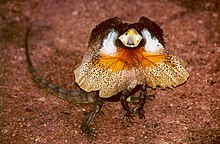Frilled lizard
| Frill-necked lizard | |
|---|---|

| |
Secure
| |
| Scientific classification | |
| Kingdom: | |
| Phylum: | |
| Class: | |
| Order: | |
| Suborder: | |
| Family: | |
| Subfamily: | |
| Genus: | Chlamydosaurus
|
| Binomial name | |
| Chlamydosaurus kingii Gray, 1827
| |
The Frill-necked Lizard, or Frilled Lizard also known as the Frilled Dragon, (Chlamydosaurus kingii) is so called because of the large ruff of skin which usually lies folded back against its head and neck. The neck frill is supported by long spines of cartilage, and when the lizard is frightened, it gapes its mouth showing a bright pink or yellow lining, and the frill flares out, displaying bright orange and red scales. The frill may also aid in thermoregulation.
Characteristics

Adult frill-necked lizards may grow up to one metre in total length. They often walk quadrupedally when on the ground. When frightened they begin to run on all-fours and then accelerate onto the hind-legs. In Australia, the frill-necked lizard is also known as the "bicycle lizard" because of this behaviour. Males are significantly larger than females both as juveniles and when mature. The frill of the Australian frilled dragon is used to scare off potential predators — as well as hissing and lunging. If this fails to ward off the threat, the lizard flees bipedally to a nearby tree where it climbs to the top and relies on camouflage to keep it hidden. im a nerd
Range and Ecology
The lizard is found in southern New Guinea, as well as in the Kimberley region of Western Australia and across northern Australia. It primarily inhabits savanna woodlands, but may also be found in tropical to warm temperate forests, and where there is an open scrub or tussock grass understorey. It is semi-arboreal, and hunts in the trees for small arthropods (including caterpillars and cicadas), and on the ground for ants and termites, spiders, or small vertebrates (e.g. other lizards). The lizards are less active during the dry season (April-August)
The only reported predators are Morelia.
Breeding
Frill-necked lizards breed in the early wet season from September to October. Adult males fight for mates, displaying their frills and biting each other. One to two clutches of 8-23 eggs are laid from early to mid-wet season from November to February. The eggs are laid in a nest 5-20 cm below ground, and usually in sunny areas. Incubation takes two to three months. Sex is partly temperature determined, with extreme temperatures producing exclusively females, and intermediate temperatures (29-35C) producing equal numbers of males and females. Their eggs are soft-shelled.
Olympics and Paralympics
A frill-necked lizard featured on the reverse of the Australian 2 cent coin, until 1991.
The 2 cent coin was withdrawn from circulation in 1992 — following which the 2 cent coins and 1 cent coins were melted down to make bronze medals for the 2000 Summer Olympics in Sydney.
A frill-necked lizard, named "Lizzie" was the mascot for the 2000 Paralympic Games.
In popular culture
- The frill-necked lizard is the fauna symbol used for the Australian wildlife television program called Totally Wild.
- In the film Jurassic Park, the dinosaur Dilophosaurus was portrayed with a fictional neck frill, which was raised during attack, similar to that of a frill-necked lizard.
- In Chapter 161 of the manga series One Piece, Baroque Works use frill-necked lizards as "delivery lizards".
- A frill-necked lizard appears in the Disney film The Rescuers Down Under.
- A frill-necked lizard named Osgood appears in the anime Noozles.
- The emblem of the Australian Army's Regional Force Surveillance Unit, Norforce (North West Mobile Force) is the frill-necked lizard. The lizard was selected as the unit's emblem because of its speed, aggression, and ability to blend in with its surroundings.
- In Holes (film), the yellow-spotted lizards have frills similar to the frill-necked lizards.
- In Adventures of the Little Koala, the character "Macky Macky" is a frill-necked lizard whose neck frill raises up when he gets excited.
References
- Bedford, G. S. 1995. Anti-predator tactics from the Frilled Neck Lizard Chlamydosaurus kingii. Journal of the Victorian Herpetelogical Society 6(3): 120-130.
- Harlow, P. S. and R. Shine. 1998. Temperature dependent sex-determination in the frillneck lizard Chlamydosaurus kingii (Agamidae). Herpetologica 55(2): 205-212.
- Shine, R. and R. Lambeck. 1989. Ecology of frillneck lizards, Chlamydosaurus kingii (Agamidae) in tropical Australia. Australian Wildlife Research 16: 491-500.
- From The Centre: Kakadu. Australian Broadcasting Corporation 2002.
